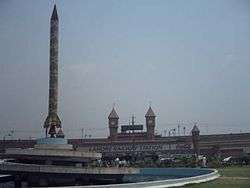Ghauri-II
| Ghauri-II/Hatf-VA | |
|---|---|
 | |
| Type | MRBM |
| Place of origin | Pakistan |
| Service history | |
| Used by | Pakistan |
| Production history | |
| Designer | Khan Research Laboratories (KRL) |
| Manufacturer | Khan Research Laboratories (KRL) |
| Specifications | |
| Weight | 17,800 kg |
| Length | 18.00 m |
| Diameter | 1.35 m |
| Warhead | 1200 kg conventional or Strategic nuclear weapon |
|
| |
| Engine | Single-stage liquid propellant rocket motor |
| Propellant | Liquid fuel |
Operational range | 1500-1800 km[1][2] |
Guidance system | Inertial guidance system (INS), GPS satellite guidance[3] |
Launch platform | Transporter erector launcher (TEL) |
The Ghauri-II (Urdu:غوری-اا; official codename: Hatf–VA Ghauri–II), is a Pakistani surface-to-surface medium range guided ballistic missile designed and developed by the Khan Research Laboratories. It is a single-stage liquid fuel missile system and a longer ranged variant of the Ghauri-I. The development of Ghauri-II took place in a direct response to India's Agni II.[4] It was developed by increasing the length of the motor assembly and using improved propellants.[5][6]
The Ghauri–II enjoyed distinction of being Pakistan's longest range missile until its limit was exceeded by the successful launch of the Shaheen-II which was tested in 2004.[7]
Design
The Ghauri-II missile has a maximum range of 2,000 km (1,200 mi). It is 18.0 m in length, has a diameter of 1.35 m and a launch weight of 17,800 kg. Its payload is a single separating warhead weighing 1,200 kg, or as low as 750 kg for use at its maximum range.[5] This may used to carry a 250 kg warhead of a 15 to 30 kt yield nuclear, HE or sub-munition warhead. The missile uses a single-stage liquid propellant rocket motor.
The Ghauri-II design improves accuracy by an employing mechanisms that spin the single booster stage and warhead combination approximately 10 seconds before the termination of the powered flight phase at 110 seconds.[3] At this point, the warhead is then separated from the booster stage to fly on a re-entry trajectory that remains stable to its target, greatly enhancing the missile's accuracy. With the addition of GPS targeting the warhead accuracy is further enhanced.[3]
Like most Pakistani missile systems, transporter erector launcher (TEL) vehicles are used to transport and launch Ghauri II.
Developments and tests
The development of Ghauri-II took place in 1993 at the Khan Research Laboratories (KRL) after the government issued orders and released funds for it.[8] After heavy reengineering and subsequent reverse engineering led the improvements of Ghauri-II, and synergizing expertise from various strategic organizations allowed the Ghauri project to continue into Ghauri II and III missiles, whose ranges were intended to reach more deeply into India.[9] Unlike Ghauri-I, the development on the second variant was kept extremely secretive and very few officials, including its chief designer, knew about the existence of the program.[9] The Ghauri-II was launched in a direct response to India's development on Agni-II and the project took place at the KRL.[4] The development on Ghauri-II remains extremely secretive and very few details were made to public in 1999.[9]
On April 11, 1999, India announced to the hold the tests for the Agni-II, prompting Pakistan's reaction. On 14 April 1999, the Ghauri-II was test fired from a Tilla-Jagun Test Range.[10] Pakistani news media inccorrectly broadcast the news that it was a re-test of the Ghauri-I; this was contradicted by Prime Minister Nawaz Sharif on 14 April 1999.[10] The Ghauri-II was launched at 1035hrs local time (0535 GMT) and its spaceflight hit a target 1150km away near the coastal town of Jiwani on the Balochistan coast.[4][10] The test was described as "successful", and the missile had taken the spaceflight more than 620mi (997.93km) in 12 minutes after being fired from a site in the central province of Punjab.[11]
The Ghauri-II enjoyed its distinction of being the longest range missile in service with Pakistan military, until its limit was exceeded by the successful launch of the Shaheen-II in 2004.[12]
See also
- Related developments
References
- ↑ "Archived copy". Archived from the original on 2008-10-07. Retrieved 2009-01-06.
- ↑ "Archived copy". Archived from the original on 2012-12-29. Retrieved 2012-12-07.
- 1 2 3 Federation of American Scientists
- 1 2 3 Lodhi, SFS (19 May 1999). "New round of Indo-Pak Ballistic Missiles". Ariticle written by Lt Gen (Retd) SARDAR FS LODI examines the new missile race in SOUTH ASIA. Defence Journal, 1999. Defence Journal. Retrieved 27 December 2014.
- 1 2 Missiles of the World Archived 2008-10-07 at the Wayback Machine.
- ↑ Pakistan’s Long Range Ballistic Missiles: A View From IDEAS Archived December 29, 2012, at the Wayback Machine.
- ↑ Staff writer (10 March 2004). "Pakistan tests its longest-range missile". Dawn newspapers, 2004. Dawn newspapers, 2004. Retrieved 27 December 2014.
- ↑ Stupak, edited by David S. Greisler, Ronald J. (2007). Handbook of technology management in public administration. Boca Raton: CRC/Taylor & Francis. ISBN 1420017012. Retrieved 27 December 2014.
- 1 2 3 Khan, Feroz Hassan (2012). Eating grass the making of the Pakistani bomb. Palo Alto: Stanford University Press. ISBN 0804784809.
- 1 2 3 Bennett-Jones, Owen (14 April 1999). "Pakistan fires ballistic missile". BBC Pakistan. BBC Pakistan. Retrieved 27 December 2014.
- ↑ Galpin, Richard (15 April 1999). "Pakistan test-fires missile". Richard Galpin in Islamabad on the latest salvo in a tit-for-tat nuclear arms race. The Guardian, Pakistan. The Guardian. Retrieved 27 December 2014.
- ↑ Staff writer (15 March 2004). "http://www.dawn.com/news/392423/pakistan-tests-its-longest-range-missile". Dawn news. Dawn news. Retrieved 27 December 2014. External link in
|title=(help)